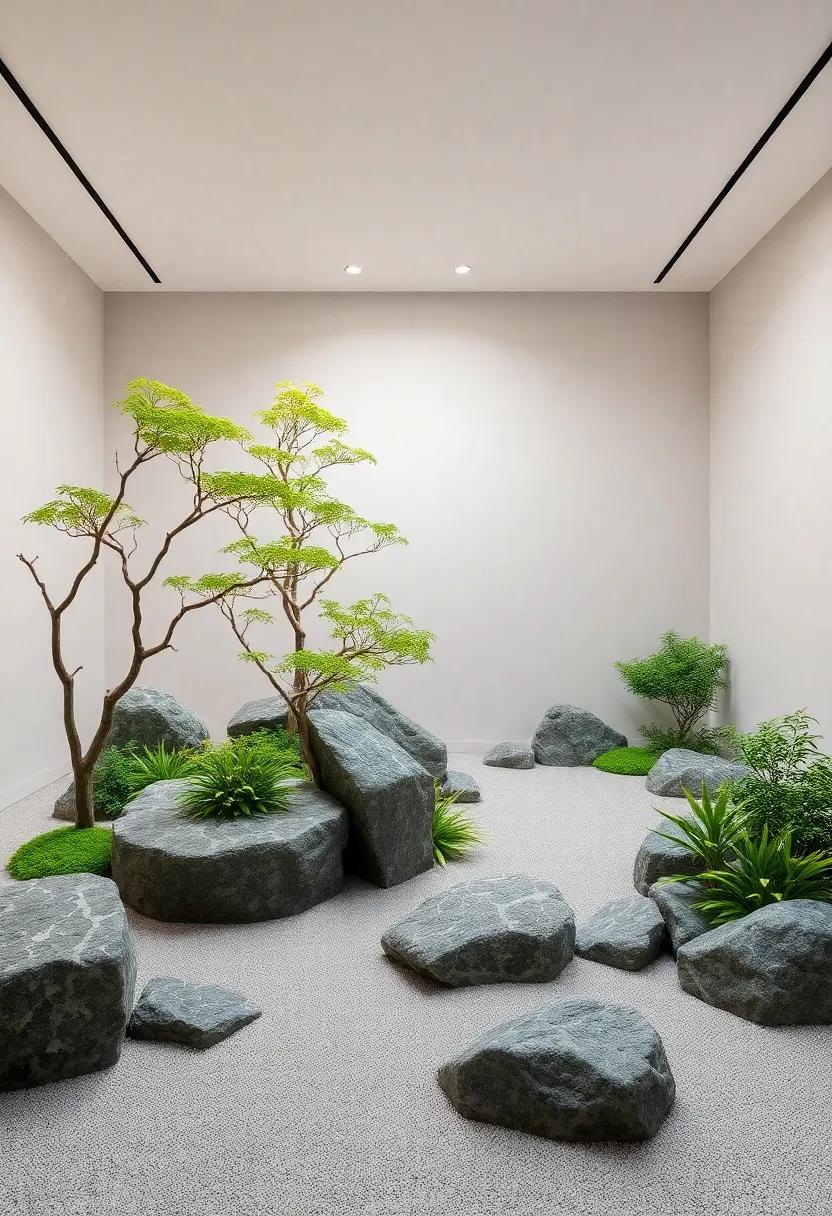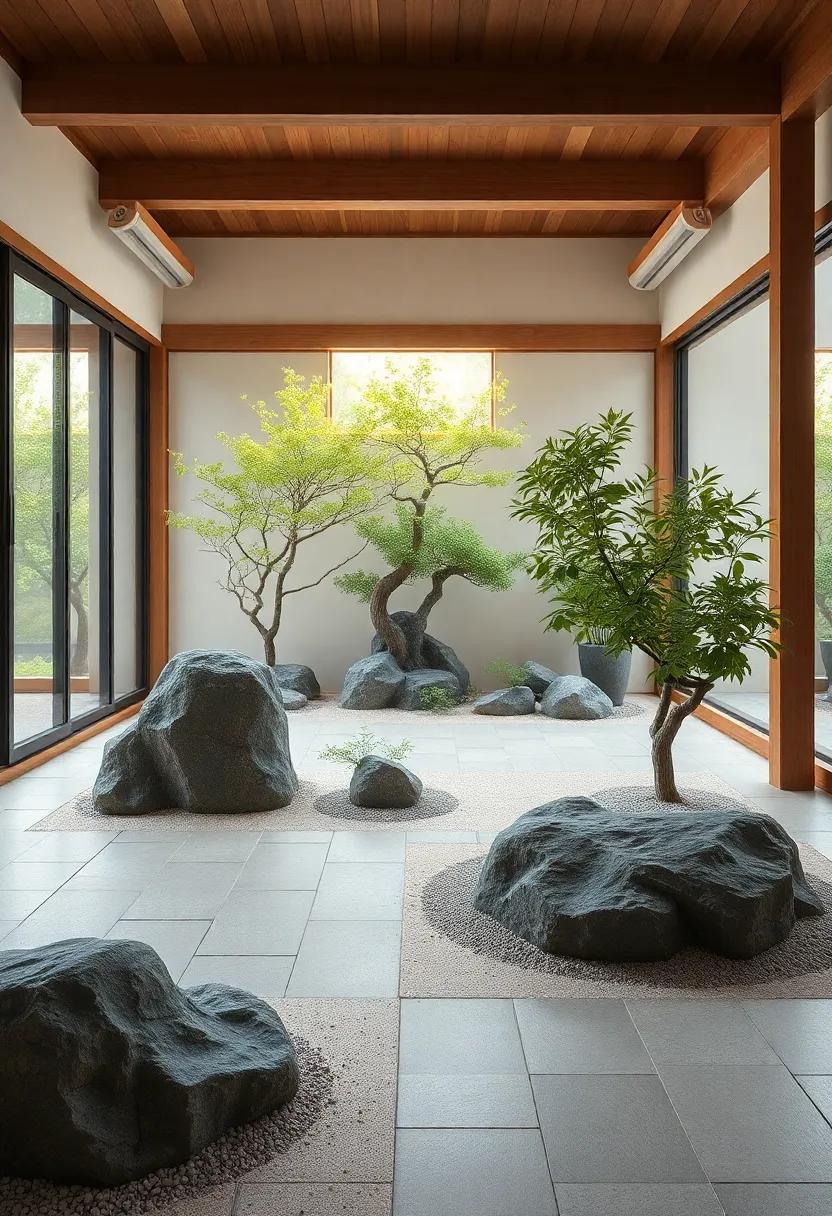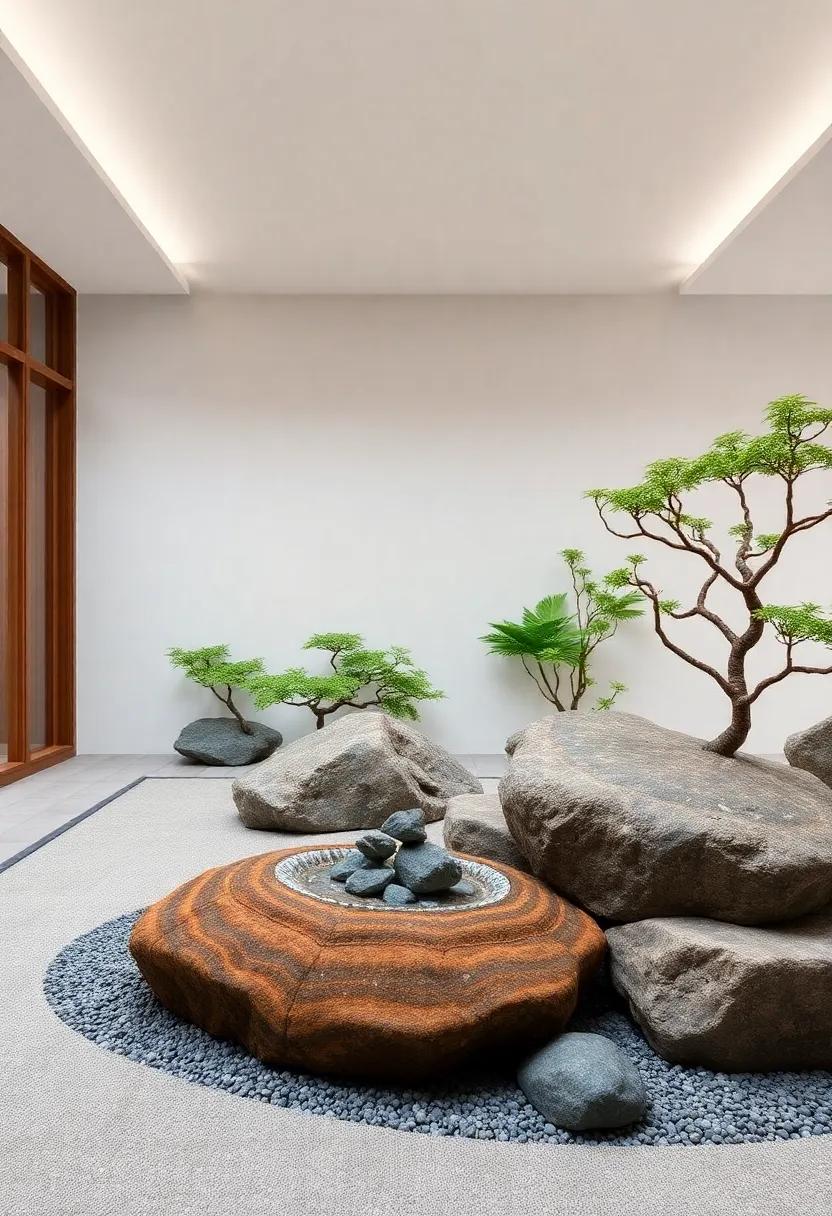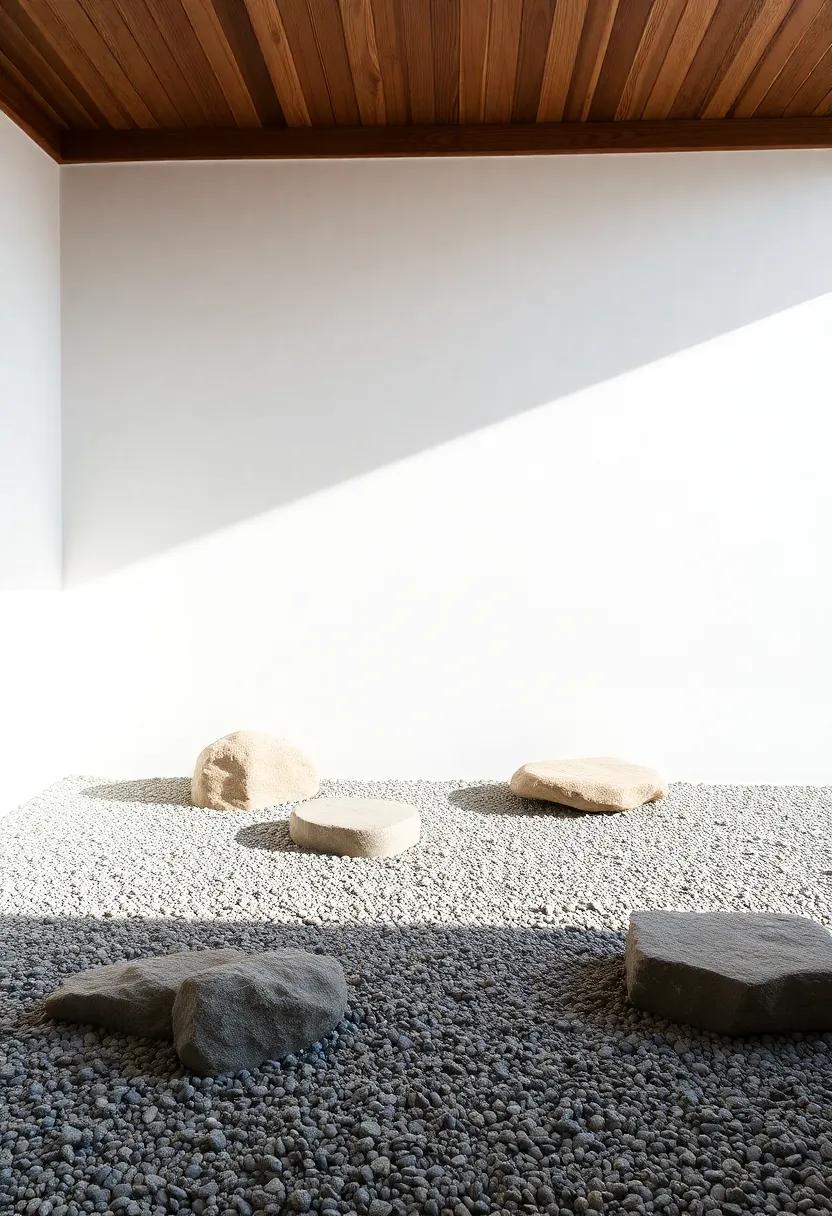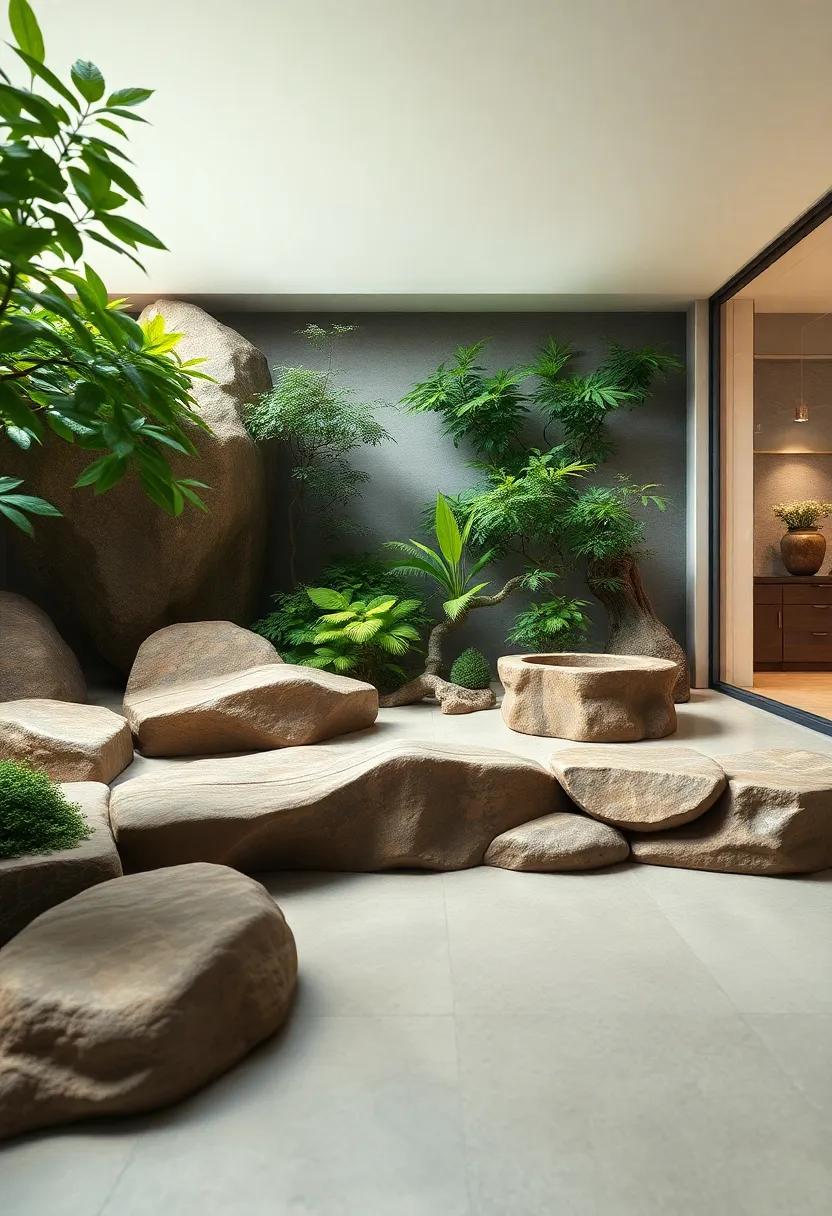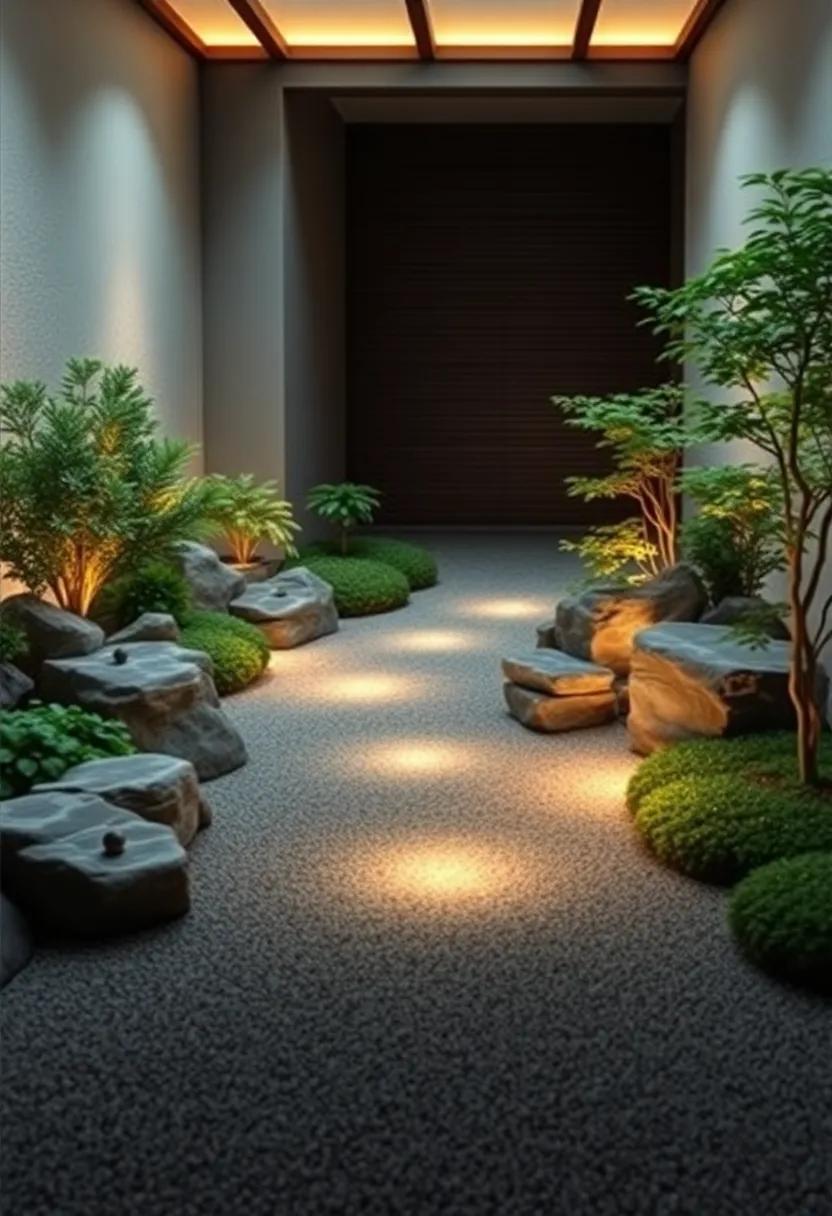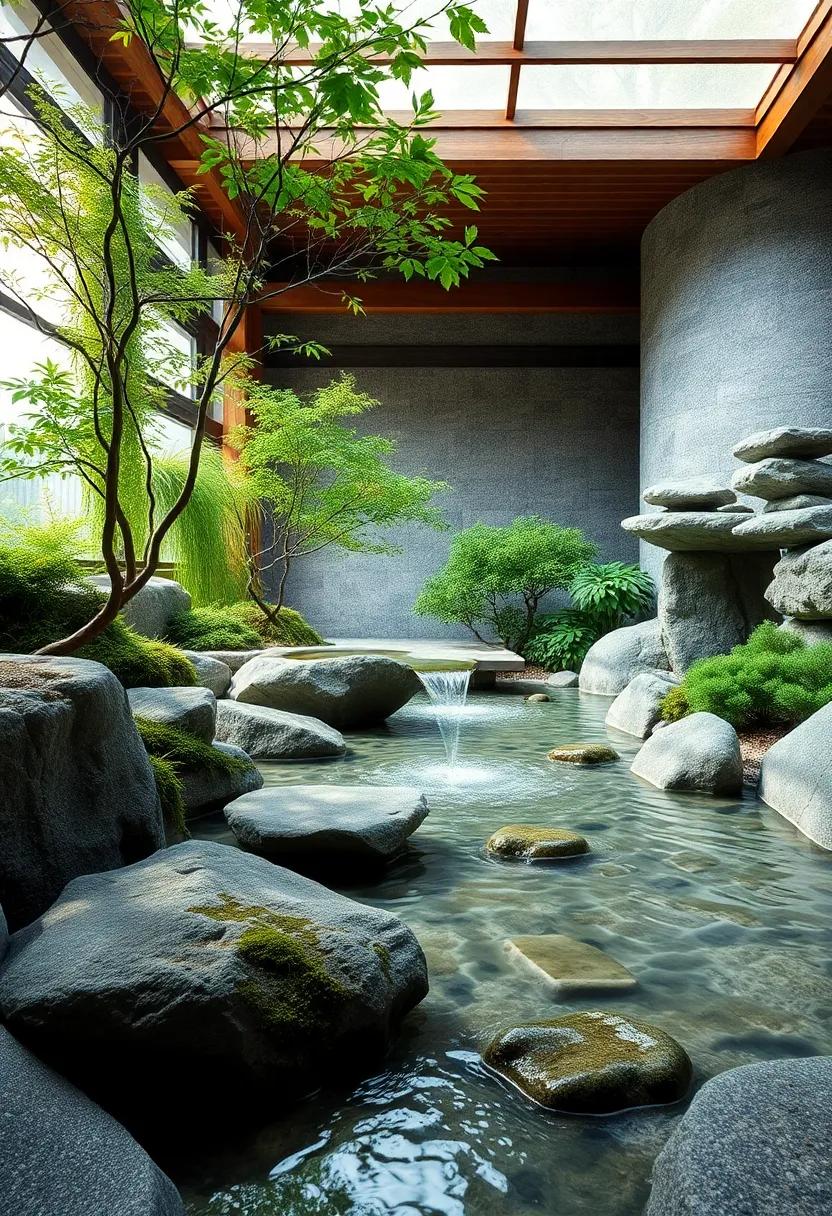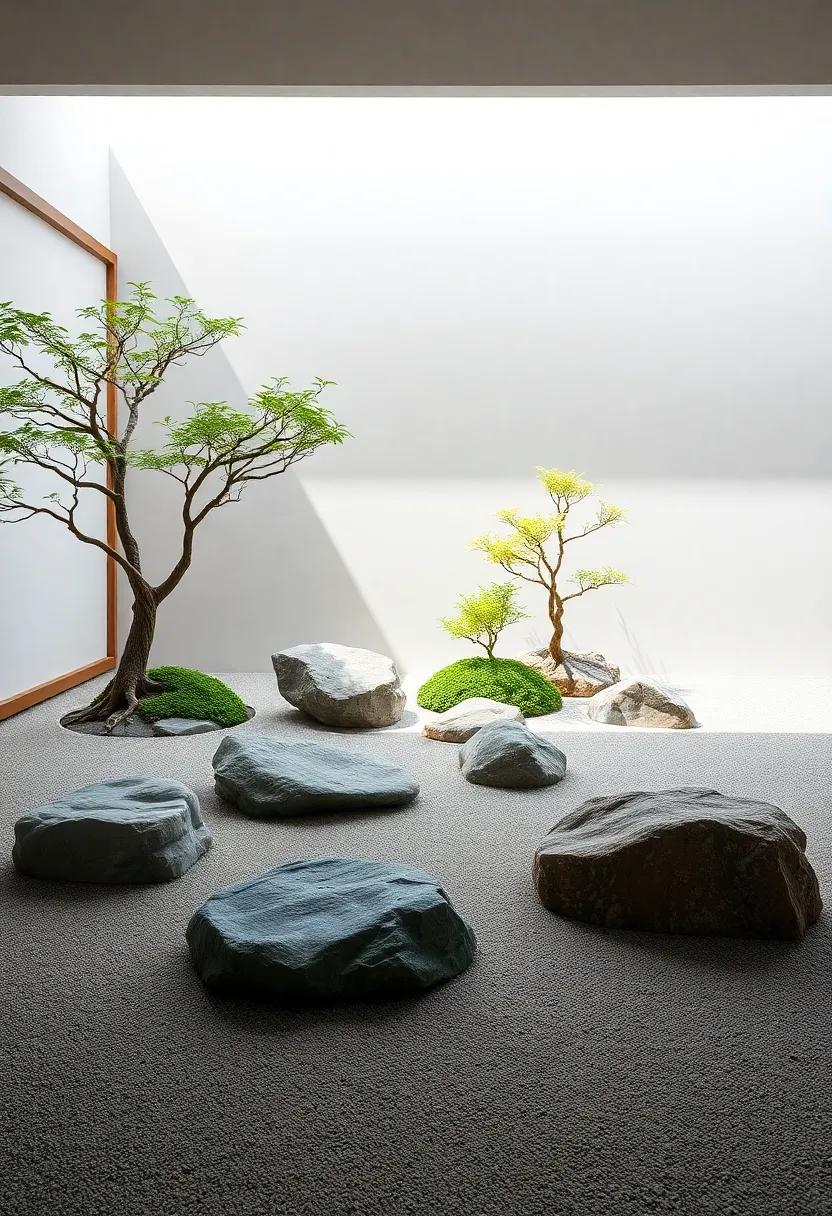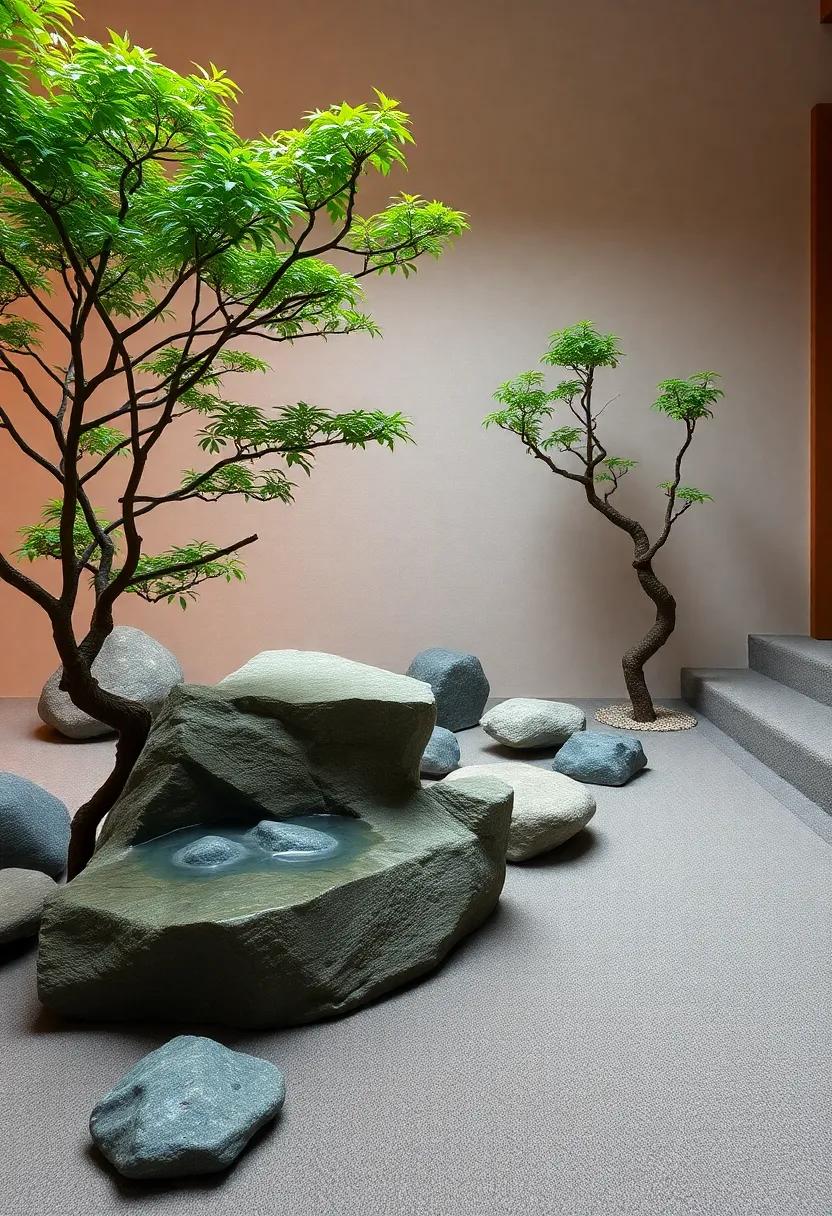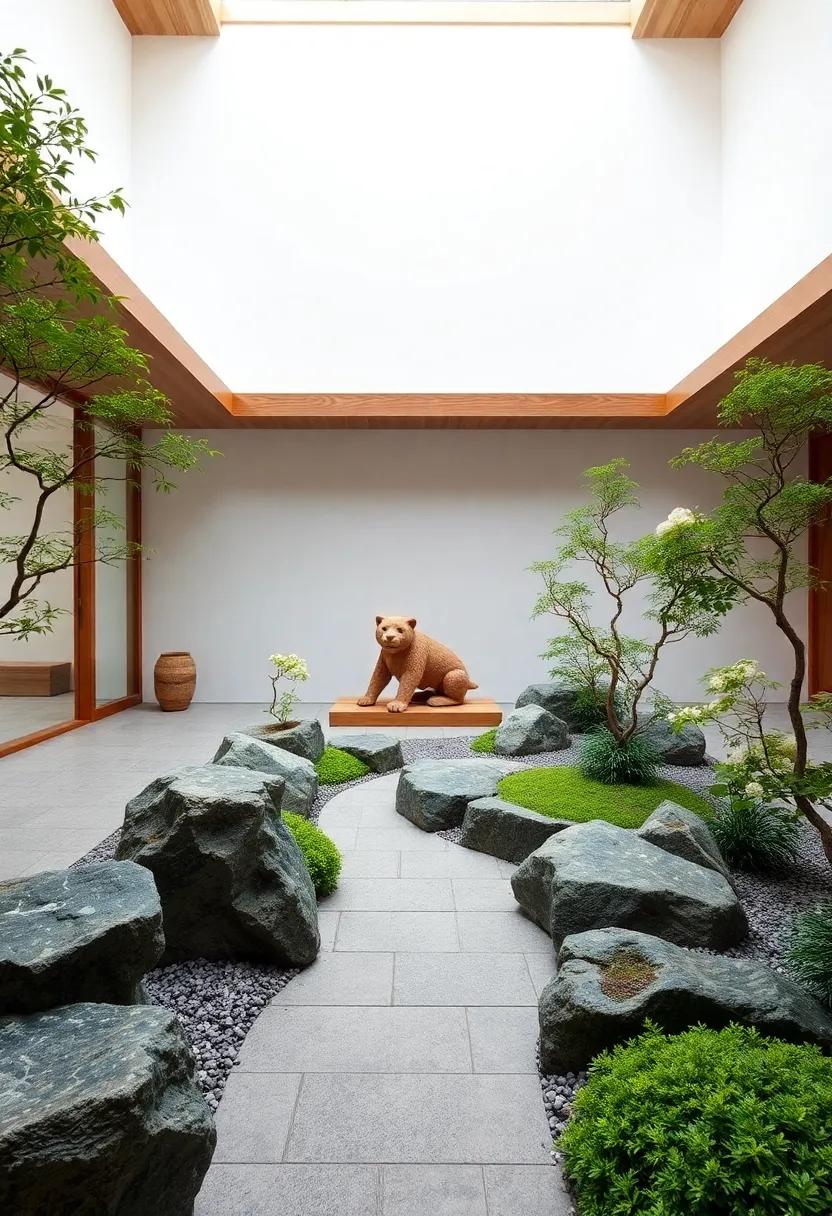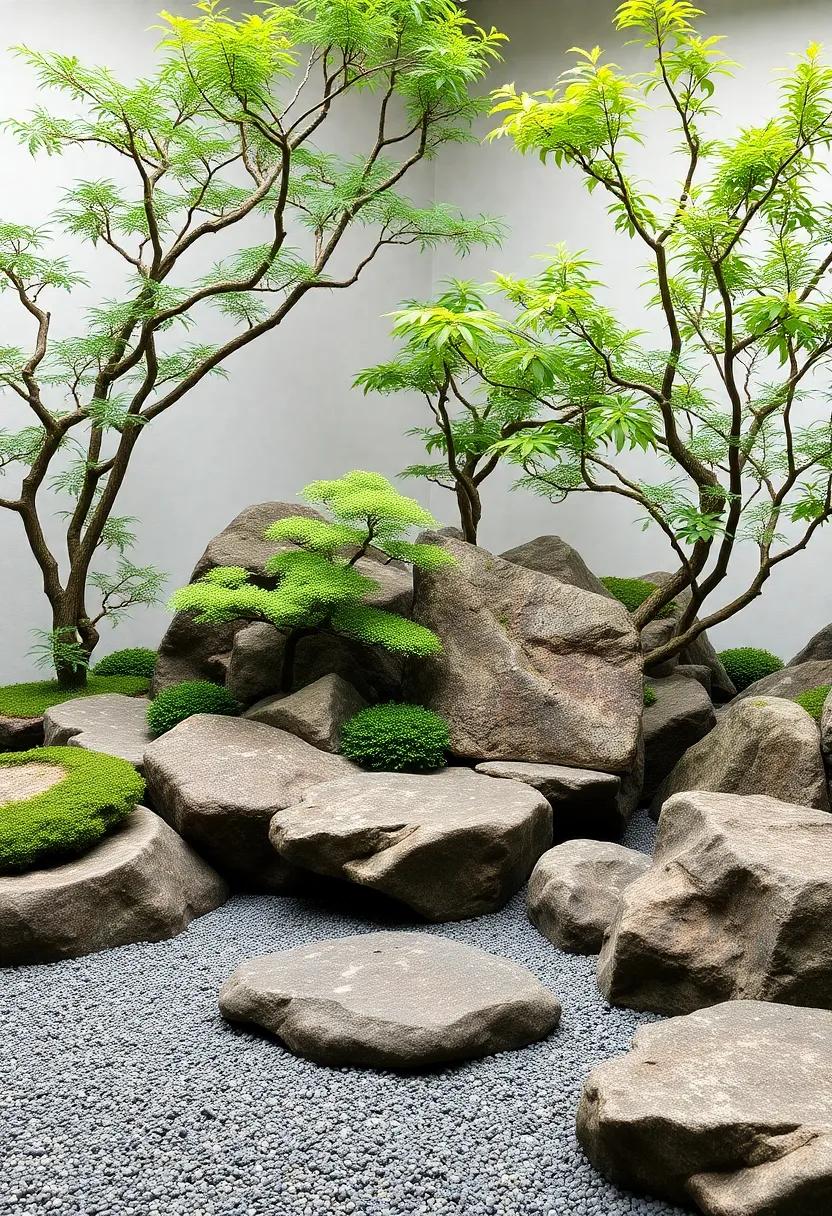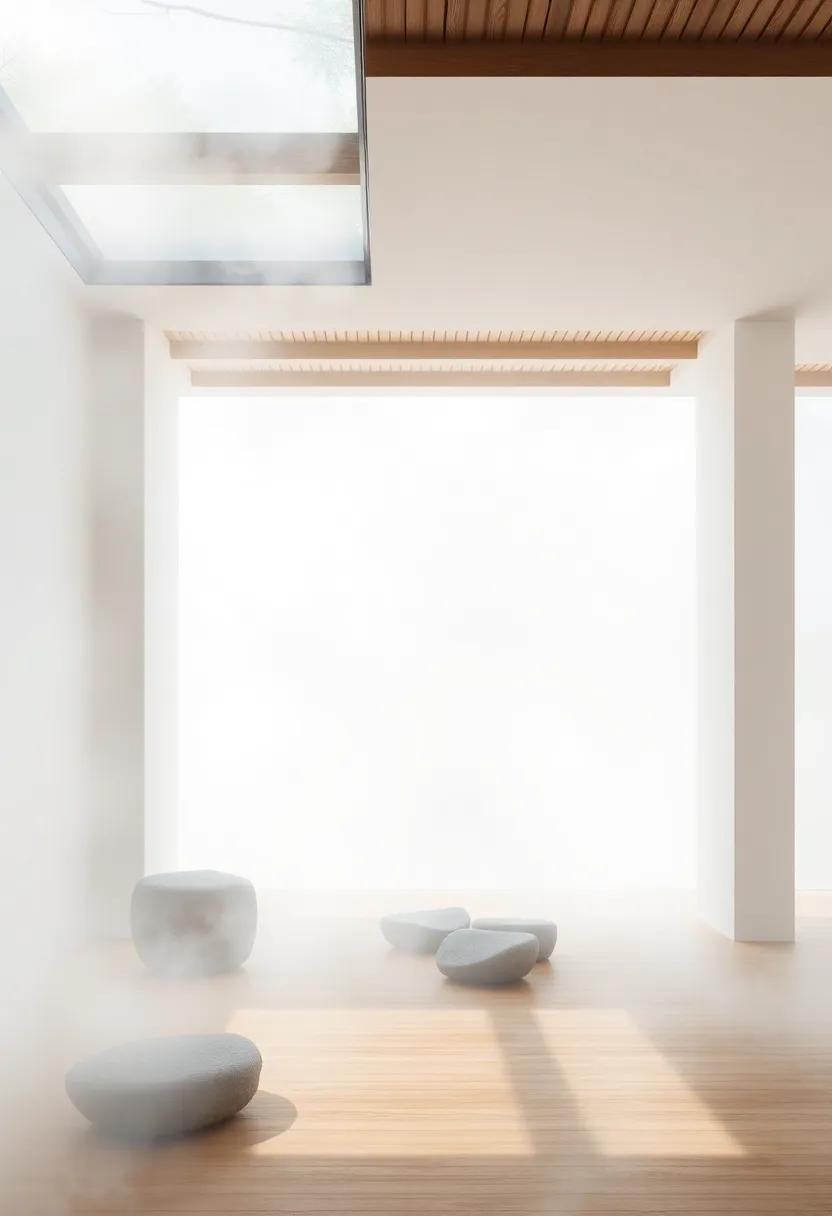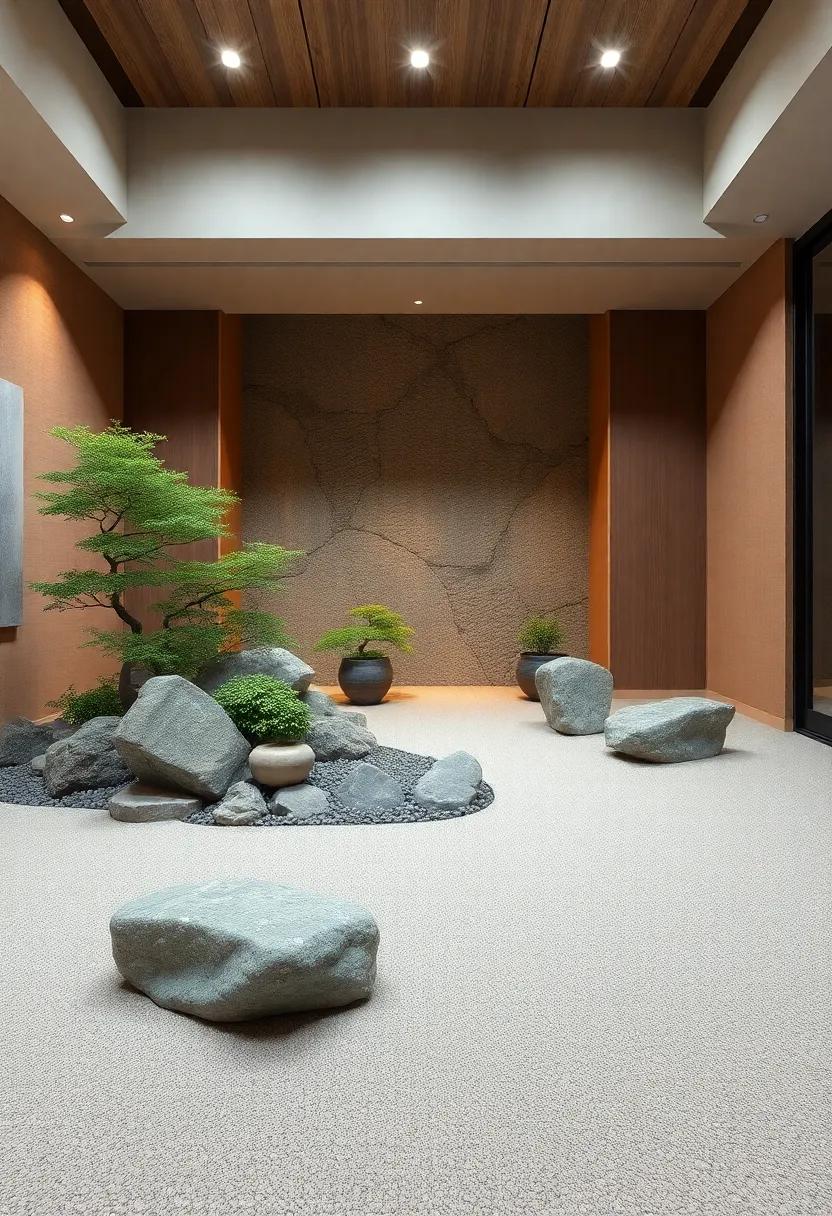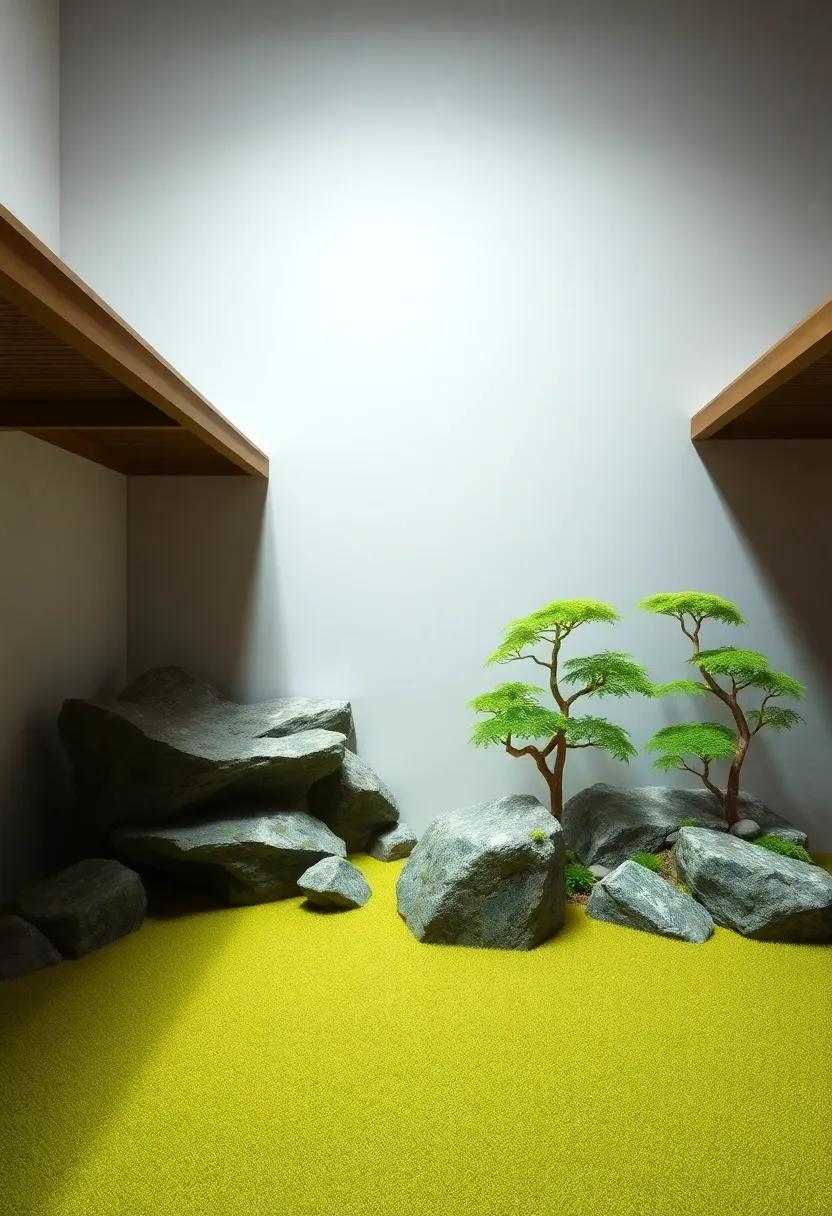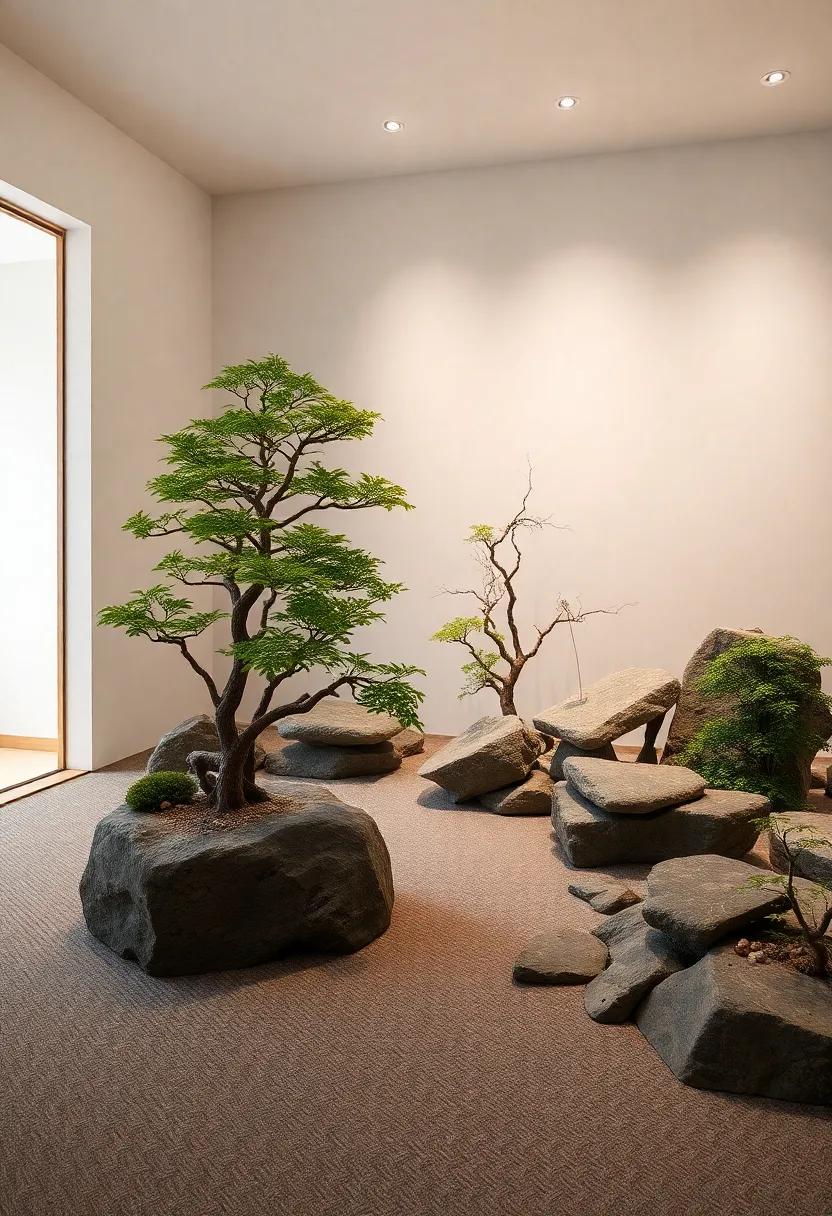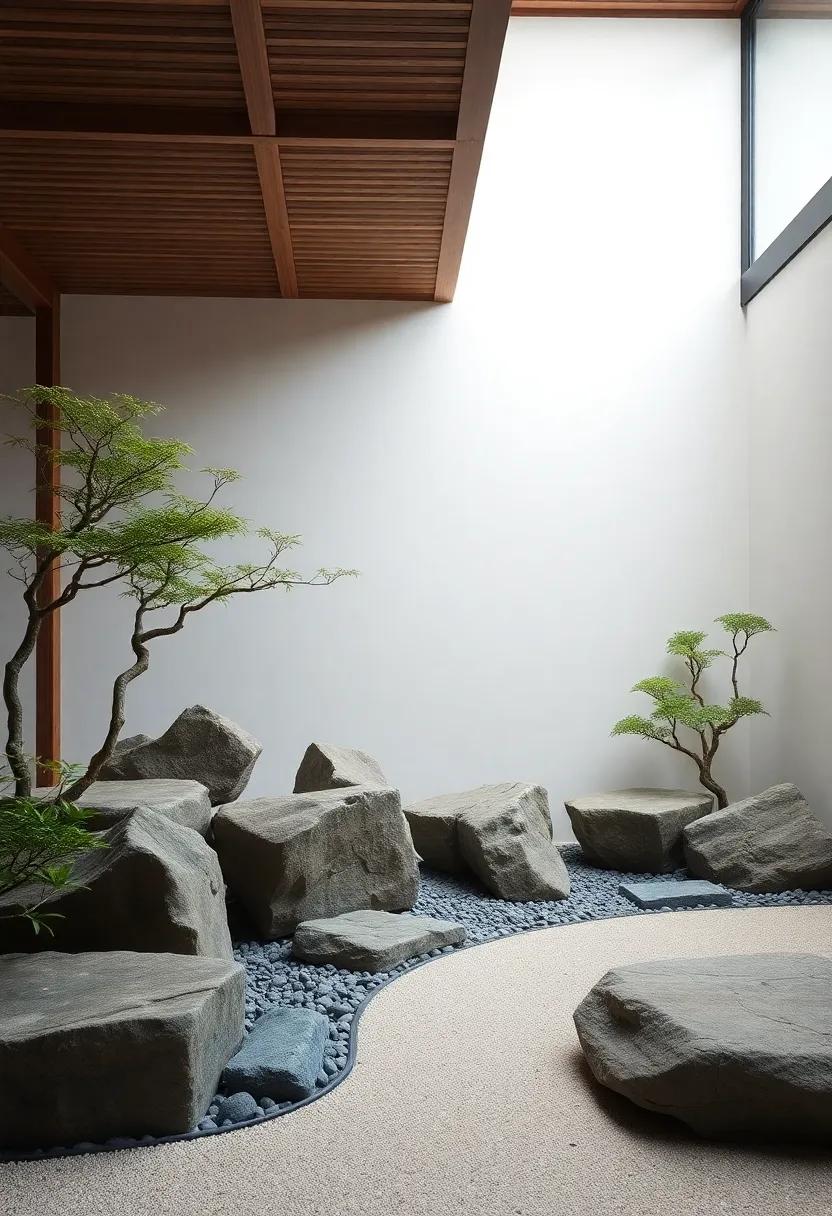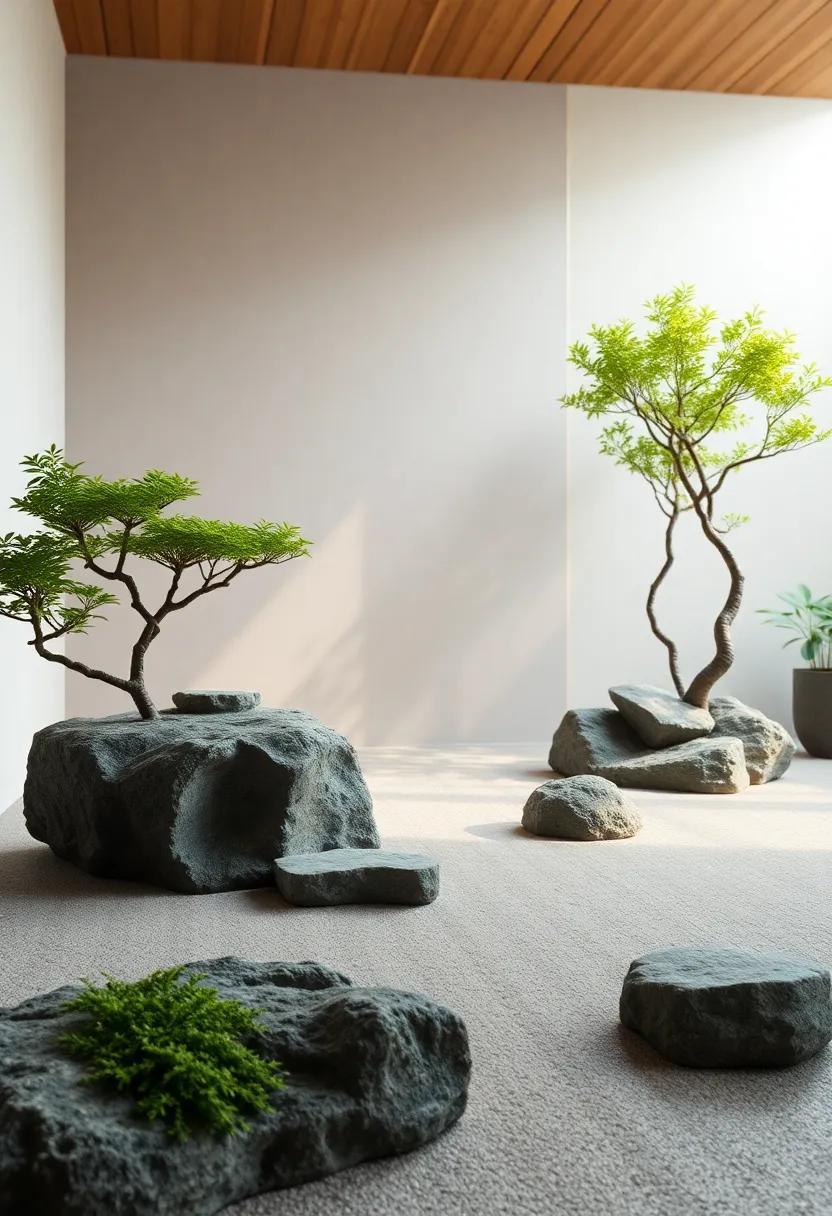
Transform Your Space: Embracing Tranquility with Indoor Japanese Rock Gardens
In today’s fast-paced world,were the clamor of daily life often takes center stage,the pursuit of tranquility has become more essential than ever. Enter the indoor Japanese rock garden—an elegant oasis that invites serenity into our noisy existence. Originating from ancient Japanese culture, these meticulously curated spaces encapsulate the harmonious balance between nature and minimalist design. By transforming your living area into a sanctuary rich with symbol and simplicity, you can cultivate a personal retreat that nurtures both the mind and the spirit. In this article, we will explore the art of creating your own indoor Japanese rock garden, delving into its philosophical underpinnings, essential elements, and practical tips to bring peace and mindfulness into your home.Join us on a journey to transform your space, one carefully placed rock and gentle rake stroke at a time.
Envisioning Peace: The Allure of Japanese Rock Gardens in Indoor spaces
Infused with the essence of nature, indoor Japanese rock gardens represent a unique opportunity to cultivate serenity within your own living space. Inspired by the principles of Zen Buddhism, these minimalist landscapes harmoniously combine elements such as rocks, gravel, and carefully placed plants to create an oasis of calm. The act of raking the gravel draws one’s attention to the present moment, encouraging mindfulness and reflection. When strategically positioned in your home, these gardens not only serve as captivating focal points but also substantially enhance the overall ambiance, making them ideal for spaces like living rooms, home offices, or meditation corners.
To craft your own tranquil retreat, consider the following elements:
- Rocks: Choose varied sizes and shapes to represent mountains or islands.
- Sand or Gravel: Use white or light-colored materials to symbolize water, and experiment with different raking patterns.
- Plants: Include low-maintenance, small plants like moss or succulents to add that touch of greenery.
- Lighting: Incorporate soft, warm lights to mimic natural sunlight, enhancing the garden’s peaceful vibe.
Creating an interior rock garden can transform a mundane space into a sanctuary.Consider arranging your garden in a tray or shallow container, which makes it easy to maintain. Here’s a simple layout to inspire your design:
| Element | Purpose |
|---|---|
| Rocks | Structure and focal points |
| Sand/Gravel | Evokes a sense of tranquility |
| Plants | Adds life and color |
| Lighting | Creates ambiance |
By thoughtfully selecting these components and taking the time to design your rock garden,you will cultivate not just a beautiful display,but also an enduring sense of inner peace in the comfort of your home.
Aesthetic serenity: integrating Natural Elements into Your Home
Incorporating natural elements into your home can dramatically enhance its aesthetic appeal and promote a sense of serenity. One particularly captivating way to achieve this is through the use of indoor Japanese rock gardens. These miniature Zen landscapes invite a peaceful ambiance into any space, combining carefully selected rocks, gravel, and minimal vegetation. This design encourages mindfulness and reflection, allowing you to escape the noise of everyday life, even if only for a moment.To create your own tranquil oasis, consider the following elements:
- Rocks: choose stones of varying sizes and shapes to represent mountains and islands.
- Gravel: Rake patterns into fine gravel to symbolize water, creating visual movement.
- Plants: Select low-maintenance plants such as moss or succulents for greenery without overwhelming the space.
- Containers: use shallow trays or wooden boxes to define the garden area and maintain structure.
once you’ve gathered your materials, the arrangement becomes an art form in itself. Emphasizing balance and simplicity is key,as is the placement of your garden within the home. Consider positioning it in an area where natural light accentuates the textures and colors of your chosen elements. For an even more personalized touch, think about adding decorative features such as lanterns or small water features to enhance the visual allure and auditory serenity. Below is a simple table illustrating potential item choices and their significance:
| item | Significance |
|---|---|
| Rocks | Symbolize strength and stability |
| Gravel | Represents calm waters and movement |
| Moss | Brings life and a touch of green |
| Lanterns | add warmth and ambiance |
Designing Your Sanctuary: Key Considerations for Indoor Rock Gardens
Creating an indoor rock garden is an enchanting way to bring a slice of Japanese serenity into your home. The first step in the design process is to select materials that resonate with the principles of minimalism and natural beauty. Stone types such as smooth river rocks, granite, or even quartz can establish an organic feel, while gravel or sand can serve as a tranquil base. Consider layering different textures to create depth, and don’t forget to incorporate moss or small plants that thrive in similar conditions to enhance the lushness.
When planning the layout, take into account the size and scale of your space.A well-balanced arrangement is crucial; incorporate visual elements such as plants, stones, and water features in varying heights to maintain interest. You might also want to include seating areas for meditation or relaxation. Below is a simple table outlining essential elements and their recommended quantities for a balanced indoor rock garden design:
| Element | Recommended Quantity |
|---|---|
| Stones | 5-10 |
| Plants | 3-5 |
| Sand/gravel (kg) | 2-3 |
| Moss or Ground Cover | 1-2 sheets |
Textures of Tranquility: Selecting Stones and Gravel for visual Harmony
Creating an indoor Japanese rock garden relies heavily on the selection of stones and gravel, which will serve as the foundation for both aesthetic appeal and a sense of calm. Consider incorporating a variety of natural stones that convey tranquility through their colors and textures. The following types of stones can enhance your space:
- River Rocks: Smooth and rounded, offering a sense of fluidity
- Lava Stones: Adding a rustic element with rich textures and colors
- Slate Pieces: Providing a deep, earthy palette and angular shapes
For gravel selection, it’s essential to choose materials that complement your stones while fostering a harmonious environment. The use of different gravel sizes and colors can create visual interest and depth. Consider these options:
| Gravel Type | Characteristics |
|---|---|
| Natural Pea Gravel | Soft, rounded, and versatile, ideal for walking paths |
| Crushed Granite | Angular and sturdy, perfect for a textured base layer |
| Colored gravel | Adds vibrancy, allowing for a unique, personal touch |
By thoughtfully selecting stones and gravel, you can invoke a profound sense of tranquility, ensuring that your indoor rock garden becomes a serene retreat. The interplay of shapes, colors, and textures will work together to foster a peaceful atmosphere, inviting moments of reflection and relaxation into your daily life.
The Role of sand: Crafting Patterns to Inspire Mindfulness
Sand serves as the canvas upon which tranquility and mindfulness are painted in indoor Japanese rock gardens. Through careful manipulation of this humble material, intricate patterns emerge, each designed to evoke serenity and contemplation. By raking sand into harmonious lines, you invite a rhythmic flow into your space, promoting a state of relaxation and clarity. The gentle curves and geometric shapes not only represent nature, but also act as a meditative guide, helping you center your thoughts and encourage a deeper connection to the present moment.
To maximize the benefits of sand in your indoor garden, consider experimenting with various techniques and tools to craft your designs. Here are some ideas to inspire your creativity:
- Utilize Different Raking Tools: Try using a bamboo rake or a fork for varied textures.
- incorporate Natural Elements: Combine sand with pebbles, stones, and small plants to enhance visual appeal.
- Establish Centerpieces: Position larger rocks or sculptures strategically within the sand to create focal points.
For those seeking structure in their designs, you might find it helpful to incorporate a simple table of patterns and their associated meanings:
| Pattern | Meaning |
|---|---|
| Waves | Flow and positivity |
| Circles | Unity and wholeness |
| spirals | Growth and conversion |
Flora and Foliage: Incorporating Plants for Lush Ambiance
To achieve a tranquil ambiance in your indoor Japanese rock garden, consider incorporating a variety of lush plants that not only enhance its beauty but also promote a sense of serenity. Select plants that resonate with the core principles of Japanese aesthetics,emphasizing simplicity and naturalness. A few ideal options include:
- Bamboo: Represents strength and resilience, adds vertical interest.
- Moss: Provides a soft, green carpet, perfect for creating a sense of depth.
- ferns: Their delicate fronds bring a gentle touch, encouraging a sense of peace.
- Japanese maple: Known for its stunning foliage, it can serve as a stunning focal point.
To maintain a cohesive design, consider arranging your chosen plants in layers, utilizing pots and other containers that blend seamlessly with the stone elements of your rock garden. This thoughtful integration creates balance and visual harmony. additionally, consider the use of color, texture, and height to inject dynamism into your space. Here’s a simplified view of how to incorporate plants:
| Plant Type | Feature |
|---|---|
| Bamboo | Tall and elegant, ideal for height |
| Moss | Ground cover, brings softness |
| Ferns | Textured foliage, adds lushness |
| Japanese Maple | striking color, serves as a focal point |
Symbolism in Simplicity: The Cultural Significance of rock Gardens
The essence of a rock garden is deeply intertwined with concepts of minimalism and Zen ideology, where every element is chosen with intention. In traditional Japanese culture, such spaces are a microcosm designed to evoke a sense of peace and reflection. The scattered stones, raked gravel, and carefully placed plants transcend their physical forms, representing profound themes such as tranquility, balance, and nature. By incorporating these elements indoors, individuals invite a serene atmosphere that encourages mindfulness and contemplation amidst the chaos of everyday life.
The symbolism embedded within a rock garden carries numerous layers of meaning, extending beyond mere aesthetics to reflect a harmonious relationship with nature. This practice emphasizes the importance of simplicity, where each stone serves a purpose and every detail has significance. Consider the following elements and their associated meanings:
- Raked gravel – symbolizes water, embodying the flow of life and continuity.
- Uneven stones – represent mountains, symbolizing strength and permanence.
- Plants – signify growth, resilience, and the cycles of nature.
This intricate balance of elements speaks to the cultural ethos of Japan, where the design of a rock garden fosters both personal reflection and an appreciation of the natural world, making it an ideal addition to any modern living space.
Lighting the Path: Enhancing Your Garden with Subtle Illumination
Incorporating gentle lighting into your garden can transform it into a serene oasis, especially when paired with the tranquil aesthetics of a Japanese rock garden. To achieve a harmonious blend, consider installing softly-lit lanterns or subtle ground lights that accentuate the delicate arrangements of stones and plants. This careful illumination not only highlights the beauty of your garden but also creates an inviting atmosphere for evening relaxation.
When choosing lighting elements, it’s essential to consider their placement carefully. Here are some ideas to enhance your garden’s appeal:
- Pathway Lights: Use warm white lights to guide visitors along stone paths, creating a gentle glow.
- Spotlights: Illuminate focal points like water features or carefully arranged rocks.
- Accent Lighting: Highlight key plants or trees to enhance their natural shapes at night.
By utilizing a mix of these lighting solutions, you can create a balanced and tranquil environment that invites reflection and calm, truly embodying the spirit of a Japanese rock garden.
soundscapes of Nature: Adding Water Features for Calming Effects
Incorporating water features into your indoor Japanese rock garden can significantly enhance its soothing ambiance. The gentle sounds of flowing water create a natural soundscape that masks outside noise, cultivates mindfulness, and promotes relaxation.You might consider options such as:
- Miniature Waterfalls: Create a small cascading waterfall with smooth stones to mimic the sounds of nature.
- Reflecting Pools: A still water surface can reflect light and colors, adding visual depth and tranquility.
- Water Fountains: Choose a discreet fountain for continuous water flow that adds a melodic backdrop.
Not only do these features serve as focal points, but they also encourage interaction and contemplation. As you design your rock garden, consider the placement of your water elements to ensure they harmonize with other aspects, such as plants and stones. A simple layout could include:
| Feature | Description |
|---|---|
| waterfall | Creates sound and movement,drawing attention. |
| Pool | Provides serenity and a habitat for small aquatic plants. |
| Fountain | Add visual interest and soothing sounds of flowing water. |
Creating Zones: Dividing Your Rock Garden for Diverse Experiences
Designing your indoor Japanese rock garden can be an enriching endeavor when you consider identifiable zones that create varied experiences. Each section can be tailored to evoke specific moods or themes, enhancing the overall atmosphere. You might want to delineate areas where serene miniatures reflect nature’s peace, while another space could thrive with bold textures and colors to evoke vibrancy. Consider the following elements for your zones:
- Texture and material: Use different types of stones, pebbles, and gravel to create contrast.
- Plant Varieties: Introduce a mix of low-growing mosses and larger plants for visual dynamics.
- Water Features: Incorporate small fountains or water bowls for a soothing auditory experience.
Dividing the space can allow unique features to stand out while maintaining harmony within the overall design. A well-structured garden can lead the eye and guide the spirit through tranquil pathways. You can implement small barriers like wooden frames or decorative rocks that gently partition zones without disrupting the flow. Establishing zones might look like this:
| Zone Feature | Purpose |
|---|---|
| Zen Zone | Encourage meditation and reflection. |
| Color Burst Area | add vibrancy for lively energy. |
| Water Serenity Zone | Create a calming soundscape. |
Artful Arrangement: Guidelines for Stone placement and Design Flow
Creating harmony in your indoor Japanese rock garden starts with intentional stone placement. Select a variety of stone sizes to create depth and interest throughout the design. Large stones can be utilized as focal points, while smaller stones can act as accents to lead the eye through the space. When arranging your stones, consider these tips:
- Balance: aim for an asymmetrical layout to mimic natural landscapes.
- Flow: Arrange stones in a way that encourages a visual path, guiding viewers from one element to the next.
- Contrast: Use different textures and colors to add dimension to your garden.
Integrating natural elements, such as sand or gravel, can enhance the aesthetic appeal and create a serene backdrop for your stones. choose a sand pattern that reflects serenity, such as gentle ripples or flowing waves, which can evoke a sense of calm and balance.Consider incorporating the following elements to enrich your design:
| Element | Purpose |
|---|---|
| Sand | Creates texture and a tranquil surface for raking. |
| Moss | softens hard edges and adds lush greenery. |
| Small Plants | Brings life and color to the static stone arrangement. |
Encouraging Reflection: Building Seating Areas within Your Tranquil Space
To truly embrace tranquility in your indoor Japanese rock garden, consider designating specific seating areas that invite quiet contemplation and reflection. These nooks can serve as the perfect backdrop for peaceful moments with a book, meditation, or simply soaking in the serene ambiance of your garden. When choosing seating, opt for materials that resonate with the natural elements found in your garden. Some excellent options include:
- Bamboo benches for a lightweight, organic feel
- Stone seats that harmonize with your rock garden
- Cushioned floor seating for comfort and versatility
- Recycled wood chairs that add warmth and character
position your seating to frame beautiful views or focal points within your rock garden. For added functionality, consider incorporating small tables or decorative stone pedestals for holding tea, books, or personal mementos. Create a lovely visual with a simple layout, such as this:
| Element | Purpose |
|---|---|
| Seating Area | Quiet reflection |
| Side Table | Display personal items |
| Outdoor Rug | Add comfort and style |
With intentional placement and thoughtful choices, your seating areas will transform your tranquil space into a sanctuary where the mind can unwind and connect with nature.
Seasonal Changes: Adapting Your Garden to the Rhythm of Nature
As the seasons shift, so too should your garden’s aesthetic and atmosphere. A Japanese rock garden, with its minimalist elegance, invites you to reflect the changing rhythms of nature throughout the year. In spring, vibrant cherry blossoms inspire fresh plantings of moss and delicate succulents, enhancing the serene vibe.As summer arrives, vibrant green shades and textures can be layered with pebbles and sand, providing a lush backdrop for mindful moments of tranquility.By autumn, the true artistry comes alive as the foliage transitions to warm hues, allowing the incorporation of warm-toned stones and carefully arranged raked patterns that symbolize falling leaves.
Winter, though considered a season of dormancy, can transform your indoor landscape into a tranquil retreat. Incorporate elements like a variety of stones in muted tones and arrange them thoughtfully to echo the beauty of frost-kissed terrain. Pairing evergreen plants with the stone elements creates a striking contrast, offering a reminder of nature’s resilience even in the coldest months. To assist you in adapting your garden through the seasons, consider these tips:
- Observe Seasonal Patterns: Take note of sunlight, moisture, and wind changes.
- Select Seasonal Plants: Choose flora that thrives during specific seasons for continuous beauty.
- Invest in Seasonal Decor: Use symbols of the changing season to enhance your garden aesthetic.
Mist and Air: Elevating Atmosphere with Humidity and Ventilation
Creating an atmosphere steeped in tranquility involves not only aesthetic elements but also crucial environmental factors like humidity and ventilation. The delicate balance of mist and air plays a vital role in enhancing the serenity of an indoor Japanese rock garden. By integrating moisture through a gentle mist, you can elevate the ambiance, resulting in a space that feels both refreshing and calming.Consider the following strategies for maximizing this harmony:
- Use a humidifier: This can replicate the natural humidity found in Japanese gardens, helping plants thrive and creating a soothing environment.
- Incorporate air plants: These require minimal care and benefit from the added moisture, enhancing the overall visual appeal.
- Ventilation system: Ensure proper airflow to prevent stagnation,fostering a dynamic and inviting atmosphere.
The interplay between humidity and air purity not only benefits plants but also contributes to personal wellness. adequate ventilation helps circulate fresh air,which can enhance mood and promote relaxation. Below is a simple guide that highlights the optimal levels of humidity for maintaining your rock garden’s health:
| Humidity Level | Optimal Effect |
|---|---|
| 30-50% | Ideal range for indoor plants,promoting growth. |
| 50-70% | Fosters a peaceful atmosphere; beneficial for relaxation. |
| Above 70% | May lead to mold growth; monitor closely. |
Interactive Elements: Inviting Engagement through Textural Choices
When designing an indoor Japanese rock garden, the selection of textures plays a vital role in crafting a serene and inviting atmosphere.By incorporating different materials such as fine gravel, smooth pebbles, and rough stones, you can encourage tactile interaction that draws visitors in. Consider using a variety of colors and shapes to create contrast, which not only enhances visual appeal but also invites contemplation. Key textural elements to consider include:
- Gravel: The foundation, representing water, can be raked into patterns, allowing for personal expression.
- Stones: Different sizes can symbolize mountains or islands, creating focal points in the garden.
- Moss: Soft and lush textures add vibrancy and life, inviting the touch while contrasting with harder elements.
In addition to the materials used, the layout can encourage engagement through interactive design. For instance, the placement of stepping stones can guide visitors through the garden, compelling them to pause and reflect at each turn. To further enhance this experience, consider integrating small seating areas where individuals can meditate or enjoy the view. Here’s a simple overview of how layout choices can facilitate interaction:
| Feature | Purpose |
|---|---|
| Stepping Stones | Guide movement and create a deliberate pace. |
| Seating Areas | Encourage reflection and prolonged engagement. |
| Water Elements | Enhance tranquility and attract sensory exploration. |
Meditative Practices: Using Your Garden as a Space for Mindfulness
Engaging with your garden can be a transformative experience, especially when approached as a mindful practice. The act of tending to your plants—whether it’s watering,pruning,or simply observing—offers a unique opportunity to cultivate presence. Consider setting aside time to immerse yourself in the sensory richness of your garden: the texture of the soil, the vibrant colors of the flowers, and the soothing sounds of nature all invite you to pause and breathe. Allow yourself to be captivated by the moment, letting go of any distractions as you focus on the delicate balance of life unfolding in your space.
Here are a few practices to deepen your mindfulness while gardening:
- Breathing Exercises: Take a few deep breaths before you begin, letting the air fill your lungs and release any tension.
- Mindful Observation: Spend time simply observing the plants and insects around you; notice their movements and interactions.
- gratitude Reflection: As you tend to your plants, think of the effort it takes for them to grow and express gratitude for nature’s gifts.
| Mindfulness Activity | Benefits |
|---|---|
| Soil Meditation | Grounds you and connects you with the earth |
| Plant Listening | Enhances awareness of natural rhythms |
| Flower Arrangement | Encourages creativity and focus |
Art Inspirations: Learning from Traditional Japanese Gardening Techniques
Traditional Japanese gardening techniques offer a profound way to cultivate serenity and balance within our indoor spaces. By embracing elements such as asymmetry, natural materials, and minimalism, you can create your own indoor Japanese rock garden that mirrors the calm simplicity found in nature. These gardens frequently enough feature carefully placed stones,fine gravel,and subtle vegetation,allowing us to engage in a meditative practice through their arrangement. The act of raking patterns in the gravel can foster mindfulness, transforming a simple hobby into a restorative experience. Consider incorporating various textures, such as smooth pebbles and coarse sands, to mirror the diverse landscapes of Japan’s famous Zen gardens.
To elevate your indoor space, pay attention to the details and draw inspiration from nature’s elements. Utilize the following key principles of traditional Japanese gardening to enhance your design:
- Balance: Strive for harmony between the elements—both hard (stones, wood) and soft (plants, moss).
- Symbolism: Select stones that represent mountains or water, enriching the garden’s narrative.
- Seasonality: Include plants that change with the seasons, providing a dynamic experience throughout the year.
| Element | Purpose |
|---|---|
| Stones | To symbolize strength and permanence |
| Gravel | To represent water, aiding in visualization and reflection |
| Moss | Adds softness and a touch of greenery |
Cultural Narratives: Discovering Stories Behind Rock Garden Designs
Throughout history, the concept of the rock garden has emerged as a serene refuge, profoundly influenced by the cultural narratives of different regions. The Japanese rock garden, or “karesansui,” is a captivating example of how landscape design can weave together philosophy and natural beauty. Each element within these gardens—from the carefully raked gravel to the strategically placed stones—carries significant meaning, echoing themes of simplicity, balance, and the impermanence of life.These gardens invite contemplation and meditation, providing a canvas for storytelling that reflects the transient beauty of nature.
As you embrace the tranquility of indoor Japanese rock gardens, consider the stories that can be evoked through your designs. Many elements resonate with symbolic meanings, such as:
- Stones: Representing mountains or permanence.
- Sand or Gravel: Symbolizing water, depicting movement and flow.
- Plants: Adding life and a touch of color to the minimalistic design.
To enhance your space, contemplate incorporating a narrative that reflects your own journey, utilizing personal elements amidst traditional design cues. Below is a simple overview of possible themes you might explore while designing your own indoor rock garden:
| Theme | Description |
|---|---|
| Serenity | Utilizing soft lines and light-colored stones for a calming effect. |
| Harmony | Balancing various elements to reflect unity within diversity. |
| Reflectiveness | Incorporating mirrors or reflective surfaces to create depth. |
Balancing Nature and Space: Harmonizing Indoor elements for Tranquility
Creating a serene indoor environment involves the delicate balance between natural elements and the constructed space around them. Integrating a Japanese rock garden in your home serves as an excellent means to evoke tranquility while providing a visual focal point. the combination of various materials such as gravel, rocks, and minimalistic plants not only invites a sense of peace but also enhances the aesthetic value of the area. consider the following elements when developing your own indoor oasis:
- Gravel Texture: Use fine gravel to symbolize water, allowing the mind to wander and reflect.
- Stone Placement: Arrange stones thoughtfully; larger boulders can symbolize mountains, while smaller ones may represent islands.
- Plant Selection: Opt for low-maintenance plants like moss or miniature pines that accentuate a natural vibe without overwhelming the senses.
To further enhance the calming effect, play with the layout and lighting of your rock garden. Soft, diffused lighting can create shadows that bring depth and intrigue to the landscape. Create designated zones within the space to facilitate meditation or quiet contemplation. The table below provides tips for lighting your indoor garden:
| Lighting Type | Effect |
|---|---|
| Soft LED Lights | Creates a warm ambiance, ideal for relaxation. |
| Spotlights | Accentuates key features like stones or artfully arranged plants. |
| Lanterns | Adds a whimsical touch and introduces a gentle glow in the evening. |
Final Flourishes: Personalizing Your Garden with Unique Accents and Decor
To elevate the aesthetic appeal of your indoor Japanese rock garden, consider incorporating a variety of unique accents and decor that reflect your personal style. Here are some ideas to enhance your space:
- Ornamental Stones: Choose a mix of natural stones in varying sizes and shapes to create focal points and stimulate interest.
- Miniature lanterns: Japanese-style lanterns can add an ethereal glow while highlighting the serene atmosphere.
- Decorative Figurines: Small statues of animals or mythical creatures can impart personality and whimsy to your garden.
- Bonsai Trees: These miniature trees symbolize harmony and growth, fitting perfectly within the tranquil essence of your garden.
Additionally, don’t overlook the importance of texture and color in your accents. A small table can serve as an enchanting display area for certain elements. Consider the following options for a beautifully arranged centerpiece:
| Element | Description |
|---|---|
| Bamboo Sticks | Symbolizing resilience and harmony, they can be arranged vertically or horizontally for added interest. |
| Colored Sand | layer colorful sand to create patterns that evoke waves or ripples, enhancing visual intrigue. |
| Water Features | Small fountains or bowls can introduce sound and movement, enriching the peaceful ambiance. |
Closing Remarks
the journey of transforming your space into a sanctuary of serenity through indoor Japanese rock gardens invites us to embrace simplicity and mindfulness. These miniature landscapes, with their delicate balance of stones, sand, and carefully chosen plants, offer more than just aesthetic appeal; they provide a much-needed respite from the chaos of daily life. As you cultivate your own garden, you engage in a practice that encourages reflection, focus, and a deeper connection to nature.
Whether you’re seeking a quiet corner in your home or a meditative focal point,an indoor rock garden is a canvas for your creativity and a catalyst for tranquility. So, take a moment to breathe, arrange, and contemplate. in the interplay of rock and sand, find the stillness that may just transform not only your space but also your state of mind. Embrace the art of living peacefully, one stone at a time.
As an Amazon Associate I earn from qualifying purchases.
